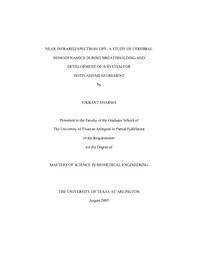| dc.contributor.author | Sharma, Vikrant | en_US |
| dc.date.accessioned | 2007-08-23T01:56:36Z | |
| dc.date.available | 2007-08-23T01:56:36Z | |
| dc.date.issued | 2007-08-23T01:56:36Z | |
| dc.date.submitted | August 2005 | en_US |
| dc.identifier.other | DISS-1074 | en_US |
| dc.identifier.uri | http://hdl.handle.net/10106/392 | |
| dc.description.abstract | Near Infrared (NIR) spectroscopy and imaging has become popular in research fields for the past 2-3 decades. My research focuses on the continuous wave near infrared imaging technique. The work consists of two main parts. In the first part, an existing commercial system, an LEDI (Light Emitting Diode Imager), is used to study the cerebral hemodynamics during breath holding. The aim was to evaluate the ability of an LED-based continuous wave imager to capture changes in hemodynamics occurring inside the skull induced by breath holding. The study involved 15 human subjects. It was found that the total hemoglobin concentration (in proportion to blood volume) within the detected region increases during the breath hold period, reaches a peak after the start of re-breathing, and comes back to normal gradually.
In the second part, the near infrared spectroscopy (NIRS) was employed to measure hot flashes, one of the most common and troublesome symptoms of menopause. During this application, I realized that it is desirable to design and build a new NIR system with a more compact and convenient probe for hot flash measurements. Thus, a low-cost, compact NIRS (LCC-NIRS) system consisting of a probe with single source and four detectors was built. The hardware consisted of a probe, a control board, a power supply, and a DAQ card which is connected to a laptop. The LABVIEW interface was used to control the hardware and to acquire data. The new LCC-NIRS system was tested for its functions by conducting two sets of experiments using both static and dynamic blood phantoms with horse blood mixed with intralipid solutions. The results obtained were found to be satisfactory to support the functions of the system.
Further development can be done to add many features to this LCC-NIRS system so as to make it more compact and eventually a wireless system, which can be very helpful for clinical uses. | en_US |
| dc.description.sponsorship | Liu, Hanli | en_US |
| dc.language.iso | EN | en_US |
| dc.publisher | Biomedical Engineering | en_US |
| dc.title | Near Infrared Spectroscopy: A Study Of Cerebral Hemodynamics During Breathholding And Development Of A System For Hot Flash Measurement | en_US |
| dc.type | M.S. | en_US |
| dc.contributor.committeeChair | Liu, Hanli | en_US |
| dc.degree.department | Biomedical Engineering | en_US |
| dc.degree.discipline | Biomedical Engineering | en_US |
| dc.degree.grantor | University of Texas at Arlington | en_US |
| dc.degree.level | masters | en_US |
| dc.degree.name | M.S. | en_US |
| dc.identifier.externalLink | https://www.uta.edu/ra/real/editprofile.php?onlyview=1&pid=28 | |
| dc.identifier.externalLinkDescription | Link to Research Profiles | |

